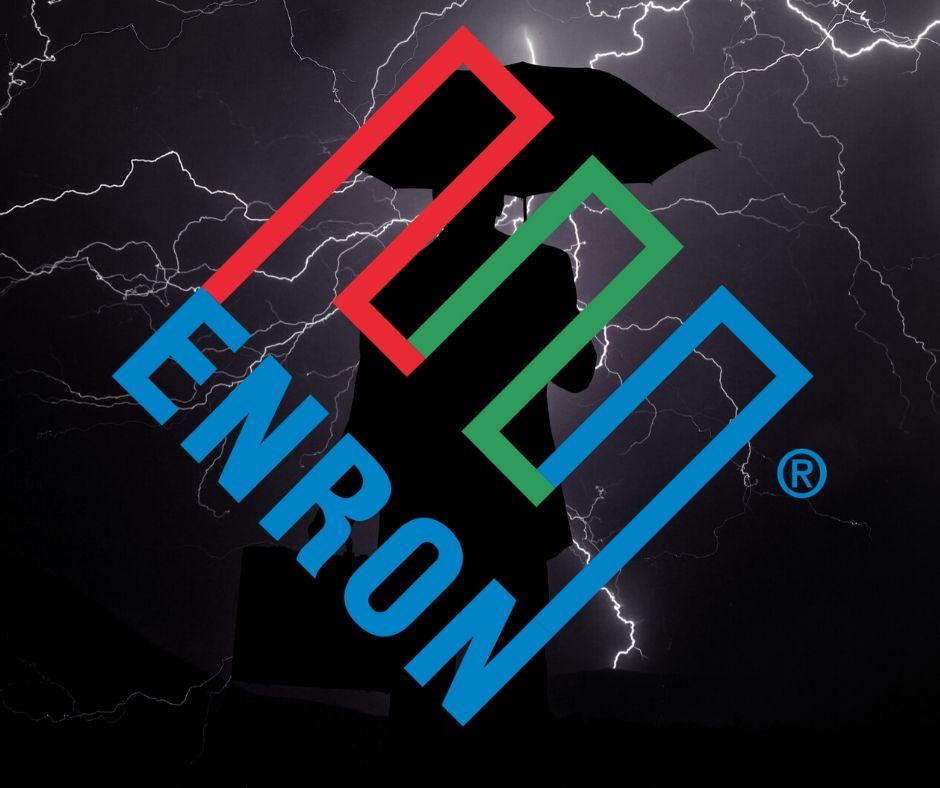Enron Bankruptcy: Reason of Collapse | Facts | Conclusion
- 26 August 2021 | 6953 Views | By Abhinav Mishra

Have you ever thought about why people do scandals? The disheartening thing is not the scandal but the fact that people who are involved in the scandal are all highly educated, financially secured, and hold top positions in the company. If you are thinking scandals are a new age disease then you are wrong. Scandals are there in the history book for a long time. Some old and popular ones are the Teapot Dome scandal of the 1920s and the defense-contractor scandals of the 1970s and 1980s.
Below are some reasons, as per experts, for scandals :
The Love for Money
Needless to say, this is perhaps the oldest temptation that can be associated with humans. We already mentioned these people are financially secure and hence the primary motive is not more money to buy more stuff but to bolster one’s self-image.
Going to the Extremes
In most cases, any company’s management focus and goal are to ensure they maximize shareholder value by doing just about whatever it takes to boost a company’s stock price. This mindset led many to take extreme steps.
The Ethics
Compliance approach is just one step above the notion that ‘following laws and regulations is all that an employee or a manager needs to do to be considered ethical but with this approach, you deal with problems that are old, not new; you’re fighting the last battle. The classic example of this is the Enron Scandal and that is what we are going to talk about in this article.
The Beginning
Enron was founded by Kenneth Lay in the merger of two natural gas transmission companies, Inter North Inc. and Houston Natural Gas Corporation in 1985. After a year the merged company was renamed Enron in 1986 from the initial HNG InterNorth.
What Exactly did Enron do?
The company lost its exclusive right to operate its pipelines in the early 1900s after the U.S. Congress brought in a series of laws to deregulate the sale of natural gas. Enron later transformed itself into a trader of energy derivative contracts, acting as an intermediary between their customer and natural-gas producers. Enron soon dominated the market for natural-gas contracts, and the company started to generate huge profits on its trades under Jeffrey Skilling’s(CEO) leadership.
Over the next few years, the company hired top MBA candidates and emphasized aggressive trading. One worth mentioning recruit was Andrew Fastow, who quickly rose through the ranks to become Enron’s chief financial officer. The bull market of the 1990s fueled Enron’s ambitions and contributed to its rapid growth for many quarters. The company started trading derivative contracts for a wide variety of commodities—including coal, paper, electricity, coal, and steel—and even for the weather.
In October 1999, Enron created Enron Online(EOL) which was an electronic trading platform that focused on commodities. In every transaction, Enron was involved – it was either the buyer or the seller. To get more people on the trading platform, Enron offered its reputation, credit, and expertise in the energy sector.
Earning through Investment made in Global Market
The peak – awards and share price
The company was named “America’s Most Innovative Company” by Fortune magazine for 6 consecutive years starting from 1996. Enron’s stock price reached an all-time high of US$90.75 per share in mid-2000.
What caused Enron to collapse?
Mark to Marketing Accounting
Before we go further, it is important to understand how the company managed its accounts. The company incorporated mark-to-market accounting for the energy trading business in 1992 and used it on an unprecedented scale for its trading transactions. Under this rule, when companies have outstanding energy-related or other derivative contracts (either liabilities or assets) on their balance sheet at the end of a particular quarter, then they must adjust them to fair market value, booking unrealized losses or gains to the income statement of the period. The major issue with the application of these rules in accounting for long-term futures contracts in commodities such as gas is that there are often no quoted prices upon which to base valuations. Companies that have these types of derivative instruments are free to develop and use discretionary valuation models based on their methods and assumptions.
Now getting to the reason as to why such a big company which was working in so many verticals collapsed:
Blockbuster Video
Blockbuster was the former juggernaut video rental chain. In July 2000, Blockbuster and Enron Broadband Services entered a partnership and decided to enter the burgeoning VOD market. As per the industry expert, VOD was a good and sensible pick but Enron started logging expected earnings based on the expected growth of the VOD market which inflated its numbers. In mid-2000, EOL was executing about $350 billion in trades and when the dot-com bubble began to burst, the company decided to build high-speed broadband telecom networks. They spent hundreds of millions of dollars on the project but had no returns. When the recession hit in 2000, Enron crumbled since it had the exposure mostly in the volatile parts of the market.
Its own weight
By the fall of 2000, the company started going down. Jeffrey Skilling was able to hide the financial losses of the trading business and other operations of the company since the company used mark-to-market accounting. Enron would build a project such as an energy plant and immediately put the profits on its financial books, even though the company had not made a single penny from the asset. In the next quarter, when the revenue from the energy plant came less than the projected amount, the company transferred the asset to an off-the-books corporation where the loss would go unreported. They never took the losses on the books.
Who took down Enron?
Though it is difficult to point fingers to a single person but amid what all was happening in the company which was taking it to south, Andrew Fastow, who was the chief financial officer since 1998 came up with a plan to project the company in sound financial shape despite the fact that many of its subsidiaries were losing money.
He along with others formulated a scheme to use off-balance-sheet special purpose vehicles(SPVs) which is also known as special purposes entities, to hide their high debts and toxic assets from creditors and investors. The standard Enron-to-SPV transaction was performed like this: Enron transferred some of its rapidly rising stock to the SPV in exchange for notes or cash. The SPV would subsequently use the stock to hedge an asset that is listed on Enron’s balance sheet. In turn, Enron would guarantee the SPV’s value to reduce apparent counterparty risk and hence turn the table on its side.
If Enron’s share prices fell, this directly compromised the ability of the SPVs to hedge. It was a very dangerous difference – Enron’s failure to disclose conflicts of interest.
Arthur Anderson was another major player in the Enron Scandal. He was running the accounting firm Arthur Andersen LLP who oversaw Enron’s accounts. The firm was one of the five largest accounting firms in the US at that time and Andersen had a reputation for quality risk and high standards management.
How was Enron caught?
Despite Enron’s poor accounting practices over the years, Arthur offered its stamp of approval and signing off on the corporate reports for years. Many analysts started to question Enron’s earnings and the company’s transparency by April 2001,
What year did Enron collapse?
Enron was in freefall by the summer of 2001. Skilling resigned as CEO due to personal reasons in August 2001. Around the same time, analysts started to downgrade their rating for Enron’s stock and the stock came down to 52 week low of $39.95. The company reported its first quarterly loss on October 16. The earning was further reduced when it closed its Raptor SPV so that it would not have to distribute 58 million shares of stock. This looked fishy and caught the attention of the SEC.
If this was not all, Enron changed pension plan administrators which forbid employees from selling their shares for the next 30 days. When the news came out that the SEC was investigating Enron and SPV, Fastow was fired from the company. The company also restated earnings going back to 1997.
By the end of 2000, Enron had losses of $591 million and had $628 million in debt. The final nail in the coffin was put by Dynegy, which had previously announced it would merge with Enron but backed the deal on 28 November 2001. Enron filed for bankruptcy on 2 December 2001 amid all crises.
Who all were punished in the Enron Scandal?
Arthur Andersen was one of the first people against whom charges were laid. Arthur’s firm was found guilty of obstructing justice for shredding Enron’s financial documents to obscure them from the SEC in June 2002. On appeal, the conviction was overturned in a few months, however, the firm was deeply disgraced by the scandal and dwindled into a holding company.
Several of Enron’s top executives were charged with insider trading, conspiracy, and securities fraud. Enron’s founder and former CEO Kenneth Lay were convicted on six counts of conspiracy and fraud and four counts of bank fraud. He died of a heart attack in Colorado prior to sentencing.
For facilitating Enron’s corrupt business practices Enron’s former CFO Andrew Fastow pled guilty to two counts of frauds – securities fraud and wire fraud. He served more than five years in prison by cooperating with federal authorities. He was set free from prison in 2011.
Former Enron CEO Jeffrey Skilling received the harshest sentence of all the people involved in the Enron scandal. Skilling was convicted of scam and insider trading. He originally received a 24-year sentence, but it was reduced by 10 years in 2013.
How many Enron employees lost their jobs?
The shareholders lost $74 billion in the four years leading up to Enron’s bankruptcy. From 2004 to 2011, the company paid its creditors more than $21.7 billion.
The day after Enron filed for bankruptcy, it fired 5000 workers which were approximately 25% of its total strength of 21,000 employees. The layoffs at Enron’s headquarters (Houston) were especially brutal, where 4,500 of the 7,500 workers were asked to leave. Laid-off workers received a mere $4,500 severance payment, the company did not take into account how many years they had worked for the company. Enron also canceled all medical and health insurance for the 5,000 laid-off workers.
What happened after the Enron collapse?
At that time, the Enron scandal was the greatest financial scandal in the history of the US economy. Post the scandal, increased oversight and regulation have been enacted to help prevent the corporate scandal of Enron’s magnitude.

Many companies reeled the damage caused by Enron for many years post 2001. The most recent incident happened in March 2017, when a judge granted a Toronto-based investment firm the right to sue former Enron CEO Jeffrey Skilling, Credit Suisse Group AG, Deutsche Bank AG, and Bank of America’s Merrill Lynch unit over losses incurred by purchasing Enron shares.









